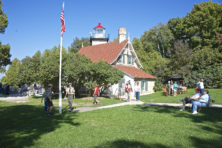Green-tinted Preservation
- Share
- Tweet
- Pin
- Share
Historic preservationists are often viewed as a nuisance in public forums. They receive a never-ending deluge of eye rolls, dismissive waves, and laughs. But when it comes to sustainability, these folks “stuck in the past” are ahead of their time.
There was a time when public buildings were beautiful odes to democracy and education. Craftsman toiled on every detail and produced monuments to stand the test of time. Today, the emphasis is on the lowest up-front cost, leading to decades of government infatuation with soulless, cookie-cutter town halls, schools, fire stations, and public spaces designed to last a couple decades and be replaced.
Tom Sadler of the Corner of the Past Museum in Sister Bay spoke about the shift.
“When they built the great museums in the early 1900s they didn’t have great mixers and our modern equipment,” he said. “The ornateness and detail they created is beautiful. Today people say we can’t do that, it’s too expensive. Leadership looks at that as something they’d be criticized for.”
Turns out historical preservation may be the ultimate “green” development, said Michael Stevens, Wisconsin State Historical Preservation Officer.
“You’re not throwing all this waste into landfills and building with new resources,” he explained. “Structures all over the state are being re-purposed as youth centers, stores, and restaurants. Ultimately those older buildings are more cost-effective then those being replaced every 30 years.”
Consider a study that shows constructing a 50,000 square foot commercial building requires the same amount of energy needed to drive a car 20,000 miles a year for 730 years. Or that a 2004 report from the Brookings Institution projects that by 2030 this country will have demolished and replaced 82 billion square feet of our current building stock. Further, it will take as much energy to demolish and reconstruct that 82 billion square feet of space as it would to power the entire state of California – the 10th largest economy in the world – for 10 years. Repurposing just 10 percent of that 82 billion square feet would save enough energy to power the state of New York for well over a year.
While it is assumed new buildings make up for their cost in energy efficiencies, recent calculations indicate that it takes about 65 years for an energy efficient new building to save the amount of energy lost in demolishing an existing building.
Meanwhile, heritage tourism continues to grow as one of the major factors in determining where travelers will spend their vacation. So next time you hear someone dismiss a plea to preserve that old town hall, school, church, or even…gulp…that bridge, it may be time to put on a pair of green-tinted glasses.
“Ironically,” Sadler said, “it seemed that when we had fewer resources and things were more difficult, communities were able to build things that were beautiful and would stand the test of time.”
Building to last – an idea that went so out of style that those buildings become a tourist attraction.


